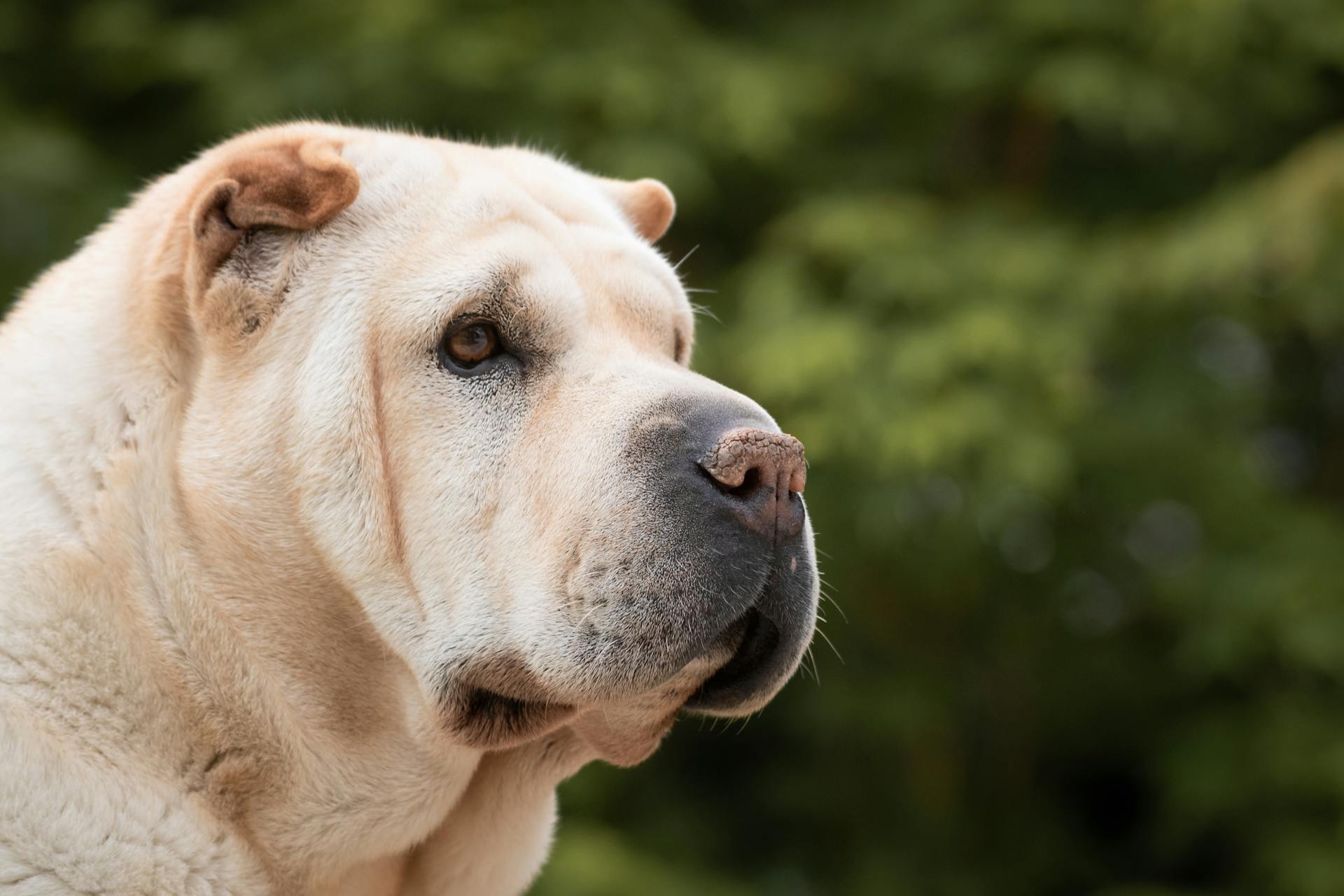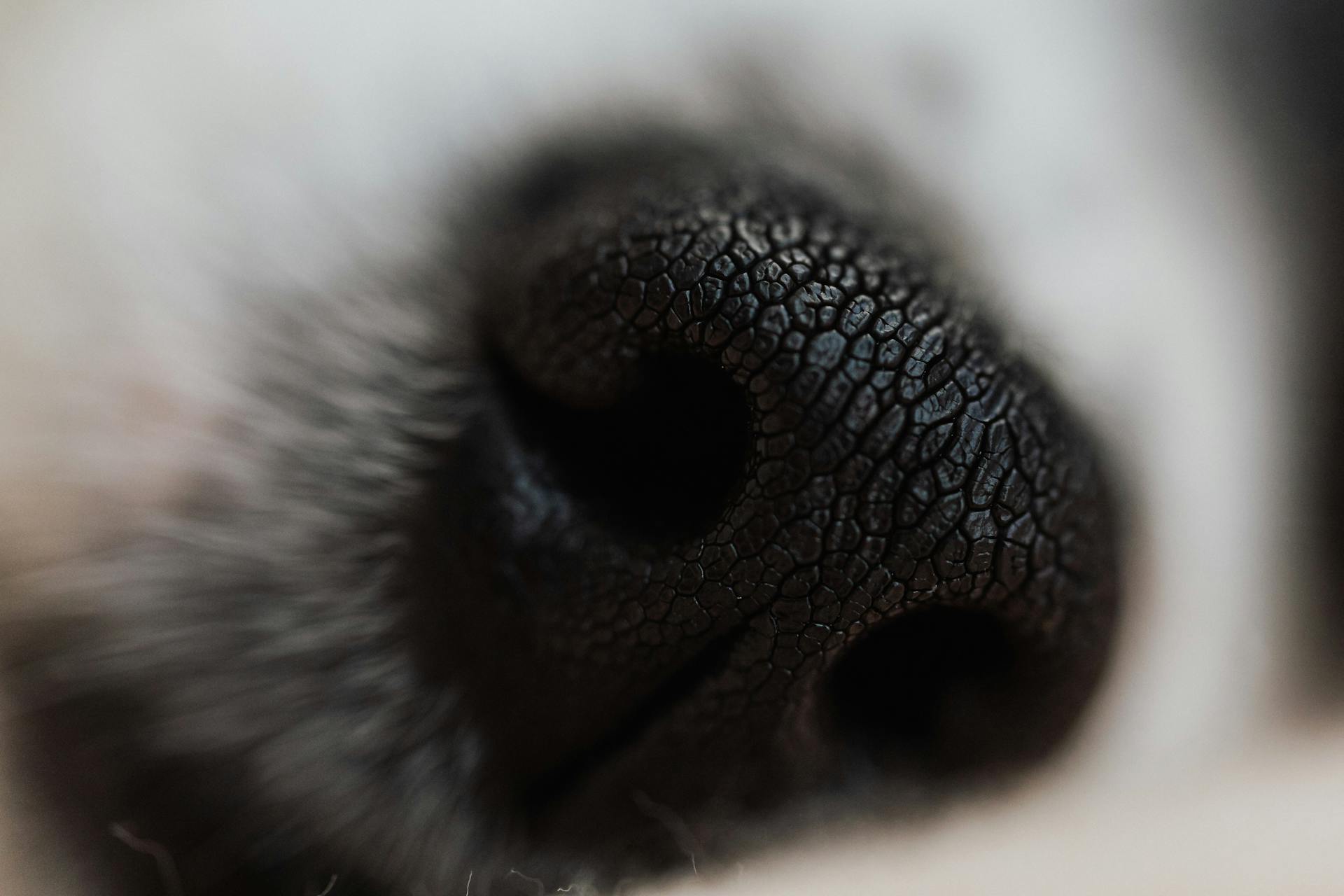
Dog warts can be a frustrating and painful problem for our furry friends.
There are several types of dog warts, including viral warts, which are caused by the papillomavirus and can appear as small, rough growths on the skin.
These growths can be painful and may bleed easily, making it essential to seek veterinary attention.
Viral warts are highly contagious and can spread quickly between dogs, especially in areas with high dog traffic.
A common type of viral wart is the cutaneous papilloma, which can appear as a small, benign growth on the skin.
Some dog warts, like the cutaneous papilloma, can be treated with topical creams or ointments, while others may require surgical removal.
It's essential to consult with a veterinarian to determine the best course of treatment for your dog's warts.
A unique perspective: Small White Dogs Breeds
What Are Dog Warts?
Dog warts are actually benign tumors caused by a virus, specifically the canine papillomavirus, which has 24 identified strains.
These lumps are completely harmless and often appear around the mouth of younger dogs.
Papillomas can grow on the skin all over the body, limbs, and face, and are usually dry, bumpy, and isolated lesions.
Most of the time, they grow outward, but in some cases, they can grow inward into the deeper layers of the skin, especially on the feet, and this type of papilloma can be slightly painful when touched.
In many cases, our dogs are not even aware of their warts and don't seem to care about their appearance.
What Causes Warts?
Warts in dogs are caused by a virus, specifically the papilloma virus, which is highly contagious and can be spread through direct contact with an infected dog or contaminated items.
This virus can cause a range of symptoms, from small, fleshy growths to large, cauliflower-like warts that can cover entire regions of the body.
Some dogs are more prone to developing warts due to their age, with young dogs under two years old commonly developing canine oral papillomas in and around the mouth and muzzle.
Papillomas can also be caused by direct contact with an infected dog or contaminated items, such as toys or feeding bowls.
The papilloma virus can cause painful lesions, especially in areas like the tummy, feet, and genitals, making it essential to consult a vet if you notice any unusual growths on your dog's skin.
In some cases, warts can become infected and require antibiotic treatment, or may even progress to a form of skin cancer called squamous cell carcinoma, which requires urgent attention.
In general, the papilloma virus is a common cause of warts in dogs, and it's essential to take preventative measures to avoid the spread of the virus.
Intriguing read: Skin Disorders in Dogs Hair Loss
Investigation and Treatment
If you suspect your dog has warts, your vet may be able to confirm the diagnosis based on the appearance and site of the lesions.
Your vet may ask you to monitor the warts or recommend investigation, especially if they're not on your dog's mouth area. They might use a needle and syringe to suck up cells from within the wart and look at them under a microscope.
Here's an interesting read: Vet Dogs Dog Treats
A surgical biopsy is another way to find out what a lump or lesion is, but it usually requires sedation or general anaesthesia.
In many cases, warts don't need treatment, and you just need to keep an eye on them. However, if the wart is bleeding, painful, or infected, your vet may recommend removing it using electrocautery, cryotherapy, or surgery.
If your dog has a wart that's not going away after three months, it's a good idea to have it checked by a vet and possibly biopsied to confirm it's just a viral papilloma.
How Are Investigated?
If your vet suspects warts on your dog, they may be able to confirm the diagnosis based on appearance and site of the lesions, especially if your dog is young and the warts are on their mouth area.
Your vet may ask you to monitor any other warts or recommend investigation. The simplest way to check a wart is to use a needle and syringe to suck up cells from within it and look at them under a microscope.

A surgical biopsy may be recommended, which involves removing part of the wart and examining the tissue under a microscope. This provides the most accurate information, but usually requires sedation or general anaesthesia.
Take photos and measurements of any lump or bump on your dog every two weeks, and check how it feels. Make sure the lighting is good and include a reference point, such as a coin or tape measure, to provide an accurate scale.
What Is the Treatment?
In most cases, warts on dogs don't need treatment and will go away on their own. However, if your dog chews, licks, or scratches at the wart, it may become painful or infected, and your vet may recommend removing it.
If your dog has a wart that's causing discomfort or infection, your vet may use electrocautery, cryotherapy, or surgery to remove it. These methods are more effective than over-the-counter wart treatments, which can be painful for dogs.

Young dogs often outgrow warts as their immune system matures, which can take one to two months. After three months, if the wart is still present, it's a good idea to have your vet check it out.
Dogs with large numbers of warts in or around their mouth may need treatment to help them eat and drink comfortably. Papillomas can be frozen off or removed surgically in these cases.
If a dog has a wart on their eyelid, it's not a good idea to wait for it to resolve on its own, as it may scratch the cornea and cause discomfort. Any lump on a dog's eyelid should be checked by a vet right away.
Frequently Asked Questions
What does a papilloma wart look like on a dog?
A papilloma wart on a dog is typically round with a rough, jagged surface, resembling a sea anemone or cauliflower. It often appears on a young dog's lips or muzzle.
How do you tell the difference between a wart and a tumor on a dog?
Dogs with benign, nonviral tumors may resemble warts, but these growths are typically easier to remove and less concerning for overall health. Look for the presence of a wart-like growth without a viral cause for a more accurate diagnosis
Sources
- https://www.petmd.com/dog/symptoms/lumps-bumps-and-cysts-dogs
- https://www.diamondpet.com/blog/health/sensitive-skin/the-12-lumps-and-bumps-of-canine-skin/
- https://camillusanimalclinic.com/faqs/oral-papilloma-virus-in-dogs/
- https://www.dogster.com/ask-the-vet/dog-warts
- https://www.vets4pets.com/pet-health-advice/dog-advice/dog-warts/
Featured Images: pexels.com


